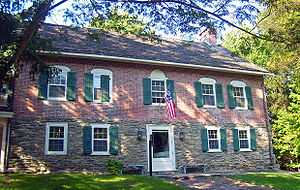Gomez Mill House
|
Gomez Mill House | |
 | |
|
House in 2007. Original 1714 fieldstone still visible in first story. | |
| Location | Town of Newburgh, NY |
|---|---|
| Nearest city | Newburgh |
| Coordinates | 41°35′12″N 78°58′53″W / 41.58667°N 78.98139°WCoordinates: 41°35′12″N 78°58′53″W / 41.58667°N 78.98139°W |
| Built | 1714 |
| Architect | Wolfert Acker |
| Governing body | Gomez Foundation for Mill House |
| NRHP Reference # | 73001245 |
| Added to NRHP | 1973 |
The Gomez Mill House is located in the Town of Newburgh, New York, USA, on Mill House Road a short distance off US 9W, just south of the Orange–Ulster county line (its mailing address is in nearby Marlboro, in the latter). Continuously inhabited for more than 280 years, it is the earliest known surviving Jewish residence in the country and the oldest home in Orange County listed on the National Register of Historic Places.[1]
History
Luis Moses Gomez, a Sephardic Jewish merchant and trader whose Spanish Jewish ancestors fled to France and England to escape from the Spanish Inquisition for the New World, came to New York in 1703. In 1705 he was granted an Act of Denization from Anne, Queen of Great Britain. This certificate gave him rights to conduct business, own property, and live freely within the British Colonies without an oath of allegiance to the Church of England. Gomez established himself as a prominent businessman and leader within the early Jewish community in New York and in 1714 he purchased 6,500 acres (2,600 ha) in Marlboro on the west side of the Hudson River in the then-British colony of New York. His house on the Hudson Highlands where several Indian trails converged served as a frontier trading post for the new colonists. Other pioneers, fleeing tyranny, and the cruelties in Europe for the promise of a new life, then settled in the Hudson Valley. On the western border of his property, he built a single-story fieldstone block house, with walls three feet (1 m) thick, into the side of a hill alongside a stream that came to be known as Jews Creek. For some thirty years he and his sons lived there and conducted a thriving fur trade from the fortress like house.[1] This remains until today the foundation and first floor of the Gomez Mill House.
In 1772, shortly before the Revolutionary War, a Dutch immigrant named Wolfert Acker bought the property. He added a second story and attic using bricks made from local clay, bringing the main part of the house into its present form. He would serve with the local Minutemen and chaired the area's Committee of Safety during the war.[1]
In the early 19th century, it passed on to William Henry Armstrong, a local farmer, and brother of the artist and diplomat Maitland Armstrong. During the half-century he and his family lived there, the kitchen wing and garden walls were added. During the next century, it had many other owners, the most notable being Dard Hunter, a papermaker associated with the Arts and Crafts movement. He bought the Mill House in 1909[2] and built a small paper mill on the property in the shape of a Devonshire cottage, complete with thatched roof, where he taught students the arts of preindustrial papermaking, printing and publishing[1] for the next seven years.[2] He sold it in 1919 in anticipation of military service. He claimed in his autobiography that a representative of the Russian government bought it for use as a school, but the real buyer was progressive activist Martha Gruening, who tried to establish a libertarian school in the building.
After World War II, in 1947, it was purchased by Mildred and Jeffrey Starin with a G.I loan. It became home to Mildred Starin and her family for the next 50 years. They were the first to recognize its historic significance. Mildred, a recognized preservationist in the Hudson Valley, restored the buildings to their original appearance and single-handedly got the property listed on the National Register in 1973.[1] Eleven years later, the New York City-based Gomez Foundation, which had been established by Mildred in 1979, purchased the house to operate it as a museum, which it does today.[2]
References
- ↑ 1.0 1.1 1.2 1.3 1.4 "Gomez Mill House: History". May 7, 2007. Retrieved 2007-12-13.
- ↑ 2.0 2.1 2.2 "Gomez Mill House:Occupants". November 1, 2006. Retrieved 2007-12-13.
External links
| |||||||||||||||||||||||||

